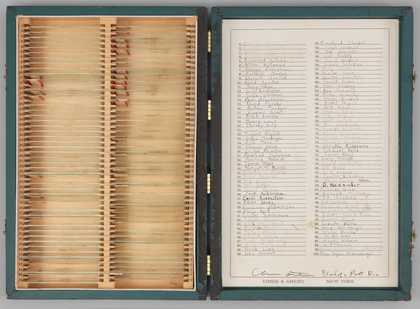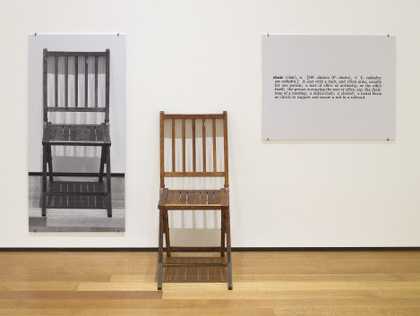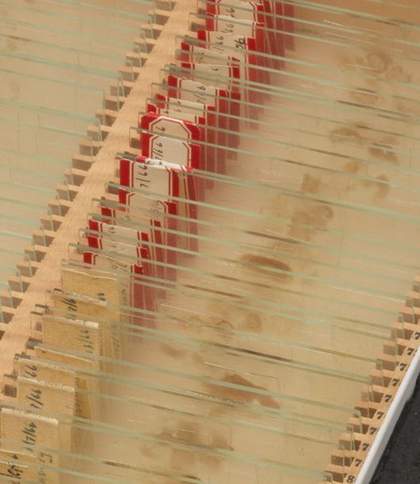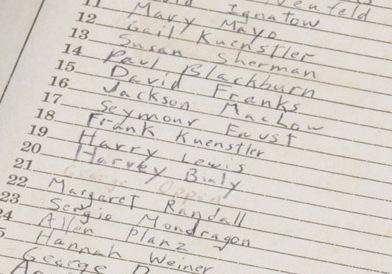
Fig.1
Eleanor Antin
Blood of a Poet Box 1965–8
Wood, cardboard, glass slides, blood, brass, paper and ink
Displayed: 28 x 290 x 405 mm
Tate T14882
© Eleanor Antin
Photo © Tate
The primary subject of Eleanor Antin’s work since the 1960s is the politics of identity. In particular, Antin has been concerned with the construction, definitions and boundaries of the subject. Writing in a 1974 essay entitled ‘An Autobiography of the Artist as an Autobiographer’, published in the journal of the Los Angeles Institute of Contemporary Art (LAICA), she described herself as ‘a post-conceptual artist concerned with the nature of human reality, specifically with the transformational nature of the self’.1 In many of her works she adopted the methods of visual and literary storytelling, biography and autobiography as a way of exploring the relationship between history and fiction. Scholars of Antin’s work have tended to focus their study of this approach on the works that Antin produced from the 1970s onwards. However, the artist’s fascination with identity, in particular the definition and presentation of the self, arguably dates to her first conceptual artwork, Blood of a Poet Box 1965–8 (Tate T14882; fig.1), which was produced during the second half of the 1960s. This chapter explores the ways in which the work investigates identity, setting it against the backdrop of the rise in identity politics in the 1960s and the broader cultural awareness of genetics during that decade.
Marking identity
Blood of a Poet Box contains two different registers for marking identity: drops of blood and a list of names (figs.2 and 3). Thus, each sitter is, in a sense, represented twice or in two separate modes. The two forms of identification – blood and name – represent two spheres of identity that can be classified as belonging to the categories of nature and culture. On the one hand, identity is presented as biologically determined, signified by a drop of blood. On the other, it is a social, cultural and linguistic construct, evident in the name that is assigned to each sitter and inscribed on the paper sheet attached to the inside lid of the box. Each slide (bar one) also indicates the name of the subject from whom the sample was taken and the date on which this took place, written on an adhesive label made from paper or fabric. What seems like straightforward record keeping initiates a tension for the viewer between different notions of identity. Which is more accurate? The blood sample might carry connotations of the precision and accuracy of scientific record, but it gives no indication of temperament, profession, intellect or social status. Being ultimately illegible to a viewer, who must take Antin’s word regarding which drop corresponds to which name, it also gives no hint as to gender or age. Even those attributes that might be ascertained via scientific examination are not accessible to the naked eye. Thus blood, clinically used to define difference and individuality, here operates as a social leveller, one that renders all sitters in a similar manner.
The work draws attention to the difference between these two systems of identification, however, in order to persuade the viewer of the impossibility of either one standing in for the sitter, whose identity is ultimately multi-faceted and unstable. The result is a subversion of portraiture, which traditionally relies on the conceit that the portrait image is a true mimetic representation of the sitter; in its place, Antin highlights the ontological distance between signifier and signified. Antin would later describe this procedure in ‘An Autobiography of the Artist as an Autobiographer’. Blood of a Poet Box, she wrote, ‘was intended to suggest relations between a smear of blood on a laboratory slide and a name’.2 These, the work implies, are more complicated than they might first seem.

Fig.4
Joseph Kosuth
One and Three Chairs 1965
Museum of Modern Art, New York
© 2018 Joseph Kosuth/Artists Rights Society (ARS), New York
The linguistic play that Antin constructs in identifying the gap between a name and a drop of blood, different signifiers of the same person, links Blood of a Poet Box to the kinds of investigations being carried out by those artists associated with conceptual art. In these terms, the work might be compared to those produced in the same period by artists such as Joseph Kosuth, whose One and Three series from 1965 presents an object alongside a photograph of that object and its dictionary definition, in order to highlight the ontological dissonance between the three (see One and Three Chairs 1965; fig.4). But while Blood of a Poet Box is undeniably a conceptual project, and Antin views it as such, she also distinguishes her approach from that of other artists more commonly associated with the term. Where the interest of so-called analytic conceptualists was in language and its limitations – ‘a bunch of formal axioms’, in Antin’s assessment – her own take on conceptual art was ‘multi media, performative, mixed genre, experimental, inventive’.3
What Antin identified as the failure of some conceptual artists was their belief in documentation as a neutral and factual representation of a given set of conditions. In fact, Antin declared, the lists and indices favoured by those artists were inevitably loaded, since
All ‘description’ is a form of creation. There is nothing more biased that scientific documentation. It presents a non-psychological image of the ‘natural order’ with no more claim to ‘objective’ truth than William Blake’s symbolic universe.4
In this light, the apparently scientific undertaking of collecting blood samples can be read as an exploration of subjectivity, rather than a rigid documentation of clear-cut identity. As such it is a poetic rather than a scientific act, or at least it is an endeavour that indicates the inseparability of those two professions.
Romantic conceptualism and constructed identity
Antin’s understanding of conceptual art closely aligns it with body art and with identity politics in the 1960s and 1970s. Her use of conceptual strategies to explore poetic genius also brings her in line with a strain of artistic practice that critic Jorg Heiser has termed romantic conceptualism.5 Writing in 2002, Heiser disputed the idea that conceptual art and romanticism are incompatible. In place of artist Sol LeWitt’s well-known dictum that conceptual art must be emotionally dry, Heiser proposed instead a conceptualism that explored the terrain of emotion, sentiment and subjectivity, often in reference to historical romanticism.6 While the states of the sublime and the picturesque seem less relevant to Antin’s project, the ways in which Blood of a Poet Box explores the relationship between the physical self and the transcendental (poetic) one would seem to locate it in the romantic realm.
In Blood of a Poet Box Antin addresses the question of whether blood samples can contain the key not only to biological characteristics, but to traits such as poetic genius that are traditionally conceived as having a mystical quality that transcends the laws of nature. This question engages with the dualistic model of identity first proposed by the seventeenth-century French philosopher René Descartes, who conceived of individual identity as being located in the mind, as distinct from the material body. The thinking self of this Cartesian model aligns with Antin’s exploration of the notion of poetic genius, while her use of a bodily fluid as a stand-in for her subjects questions the split upon which Descartes and others insisted. Blood of a Poet Box encourages us to consider what remains of the unique self, soul or poetic identity in the face of these near-identical material remnants of the body.

Fig.5
Jackson Pollock
Summertime: Number 9A 1948
Tate T03977
© Pollock-Krasner Foundation, Inc.
Just as Descartes’s assertions about identity were challenged by a number of philosophers and theorists from Karl Marx to Jacques Derrida, so the way in which Antin approaches identity and its representation is complex and ambivalent, if perhaps more playful in tone than that of the philosophers.7 Blood of a Poet Box demonstrates an interest in the idea of uniqueness asserted by the romantic myth of genius, according to which the artist or poet is a tortured and introspective individual disconnected from worldly concerns. As such, Antin’s work reflects – and reflects upon – the legacy of the heroic rhetoric of abstract expressionism, whose supporters promoted the romantic conception of singular genius and the transcendental potential of works of art. It was the affective nature of abstract expressionism to which Sol LeWitt was responding when he banished emotion from conceptualism and it was that affective engagement that Heiser aimed to recover in his designation ‘romantic conceptualism’. The action painting of artists such as Jackson Pollock was staged by critics, Harold Rosenberg in particular, as an extension of the artist’s own bodily movements, according to which the paint on the canvas functioned as a trace of the presence of the painter (see, for example, Pollock’s Summertime: Number 9A 1948; fig.5). The implications of this reading would also be picked up by abstract expressionism’s detractors, who debunked the paintings as ‘ejaculatory splat’.8 In the context of this art historical lineage, Antin’s box makes literal the metaphorical link between bodily emissions and artistic ones.
In the LAICA journal essay, Antin described the problem of presenting blood drops isolated from the body: thus rendered, blood becomes ‘merely a metaphor except to certain esoteric specialists like doctors and policemen’.9 Paradoxically, blood drawn from inside the bodies of her subjects could at best present a superficial representation of their being. By implication, bodily emissions could never convey artistic subjectivity, no matter the stance of some art critics and the painters they championed. Antin goes on in the LAICA essay to explain her turn towards a mode of portraiture that constituted its subjects out of objects rather than bodily fluids: ‘Preferring a more complex set of information cues,’ she wrote, ‘I began to construct semantic portraits of people, sometimes real, sometimes fictional, out of configurations of consumer goods.’10 For Antin, these later works, in their turn from internal to external signifiers of identity, escaped the problem of exclusivity by appealing to the universal reference points of consumer goods. This ‘more complex set of informational cues’ might also be found in Blood of a Poet Box, however, in spite of the reservations that Antin expressed.
In addition to the links that it makes between biological samples and the subject, Blood of a Poet Box also performs a third model of identity, one in which the self is integrated into its cultural and social context and constituted by elements outside of itself. This presents identity according to what art historian Amelia Jones, borrowing a term from philosopher Gilles Deleuze, has called intersubjectivity, which is the notion that the self is always constituted in relation to others, rather than following the Cartesian model of introspective self-definition.11 The relationships upon which identity is formed emerge in two ways in Antin’s box: firstly, the project represents a series of intimate exchanges between the artist and her subjects, defined by the element of trust that comes with drawing the blood of another. Such exchanges were inevitably dependent on friendship, acquaintance, professional respect, careful negotiation, or some combination of these. Antin has described this careful diplomacy, referring to the element of charm and persuasion that was necessary, especially in the early stages of the project, and recounting not only those exchanges that were successfully brokered, but also those that fell through.12 Secondly, the list in its entirety maps the complex social and cultural networks of which Antin was a part, in which there were personal and professional relationships between her sitters. Most obvious among these is the example of her first subject, her husband David Antin, whose close familial relationship with the artist is overt on account of the surname they shared. The function of names to cement the social and legal relationship of marriage is also evident in the inclusion of Gail Kuenstler and Frank Kuenstler in Antin’s list; only viewers with a certain level of familiarity, however, would recognise other married pairs who did not share a surname, such as Margaret Randall and Sergio Mondragón.
Just as the New York poetry community that the work delineates was in many ways defined by small coteries and implicit countercultural codes, so the social and professional bonds that linked those poets represented in the box remain implicit, known only to those viewers who were themselves part of the circle. To those who did not belong to this community, and despite the list of distinct names, the blood drops appear very similar, even though some are more degraded and faded than others. This tendency of Antin’s portrait to unify rather than differentiate sitters might be productively read in relation to identity politics of the late 1960s and early 1970s, in that no distinction between donors is made on the grounds of gender or ethnicity and in that the work suggests identificatory labels to be potentially misleading.
Gendering the canon
Blood of a Poet Box seems to anticipate discussions of gender equality that would come to the fore in the following decade with the rise of second-wave feminism. Women are deliberately included in Antin’s canon of poets alongside their male counterparts in a field dominated by men. Although Blood of a Poet Box predates Antin’s active engagement with the feminist movement and while she does not explicitly describe it as a feminist work, it could be seen to anticipate the gender politics that would directly inform her later work. Antin did not become fully involved in the feminist movement until after she had moved to California, where she would participate in the activities of the Los Angeles Women’s Building and contribute to the feminist project Anonymous Was a Woman 1974. The extent to which Antin’s oeuvre displays a feminist politics has been a matter of debate among scholars and critics. On the one hand, writers have identified its focus on personal narrative and female experience as aligning with the concerns and strategies of second-wave feminism. On the other, she remains at the periphery of accounts of feminism in the visual arts, in part due to a certain amount of ambivalence towards the goals of such projects and in part since, as art historian Lisa Bloom argues, ‘she doesn’t fit neatly within the feminist script of the 1970s’ due to a reluctance to align her work unambiguously with the agenda set by such projects.13
Nonetheless, Blood of a Poet Box suggests a proto-feminist sensibility on a number of levels. Firstly, Blood of a Poet Box engages with the notion of artistic ‘genius’ in a manner that questions, if not directly contests, a term that has been criticised as reductively masculinist, modernist and patriarchal. Secondly, Antin has stated that she expanded her definition of ‘poet’ in order to include more women, a move that resulted in the inclusion of Carolee Schneemann and Yvonne Rainer, neither of whom are conventionally considered poets.14 Antin’s decision to include figures such as Rainer and Schneemann in Blood of a Poet Box was motivated in part by a desire to contest and complicate established labels and terms and in part by a desire for a greater parity of gender representation within her group of sitters. Finding herself straddling the boundary between the written word and the visual arts, she applied this broader sense of the poetic to her subjects, using this expanded understanding of the word ‘poet’ to introduce several key women subjects. Unlike the motivation of the Feminist Art Program and the Women’s Building, which were established in 1970 and 1973 respectively and which both sought to establish separate female intellectual and creative space, Antin integrated men and women into the same collection.15 This procedure more closely anticipated the recuperative work done by artists and art historians who later sought to resurrect the work and reputations of forgotten women artists throughout history and to integrate them into the established canon. Antin’s observation in a 2009 oral history interview conducted by the Archives of American Art that ‘in those days there were more men poets than women poets’ seems to echo the provocative question posed by feminist art historian Linda Nochlin’s 1971 essay ‘Why Have There Been No Great Women Artists?’. Blood of a Poet Box answers the implied question in two ways: by reinserting women into the canon that it proposes, and by expanding the definition of the term poet in order to highlight its inadequacy along gendered lines.
Finally, in its exploration of the limits of biological identity, Antin’s box might be seen to reflect feminist distinctions between anatomical sex and socially constructed gender, articulated as early as 1929 by Joan Riviere in the essay ‘Womanliness as Masquerade’ and reiterated in Simone de Beauvoir’s famous dictum in The Second Sex (1949; English translation 1953) that ‘one is not born, but rather becomes, woman’.16 In both cases, the feminine gender is shown to be something that is adopted or enforced by a set of social signifiers and behaviours, quite distinct from the female sex, which is defined as biologically determined. As Antin has described, Blood of a Poet Box reveals blood – a biological signifier – to be of limited use in representing identity, if identity is to be understood as reflective of broader social categories and relationships.
Genetics in popular culture
If Blood of a Poet Box presents identity as contingent upon social relationships and therefore flexible as a category, the work itself is also to some extent influenced by the period in which it was made. The history of portraiture in both its traditional and more subversive formats inevitably reflects the beliefs and knowledge systems of its time. In the case of Blood of a Poet Box, the work might plausibly be related to the broader context of scientific discovery and its representation within the mainstream media and popular culture during the post-war decades. In 1962 the Nobel Prize for Medicine was awarded to Francis Crick, James Watson and Maurice Wilkins for their 1953 discovery of the helical model of DNA. The previous decade had seen the development of a ‘new biology’, characterised to a great extent by the widespread vindication of the field of genetics, its reputation transformed among the scientific community and in the popular imagination alike, from an ideologically suspect endeavour to a promising utopian one. The 1960s heralded an increased attention to genetics in popular culture and the media: publications such as Time and Newsweek described the scientific study of the body and blood as the key to unlocking the ‘secrets of life’ via invisible molecular information that elucidated identity and allowed for the promise of medical progress in combatting disease and disorder.17 Of course, Antin would have had only a lay knowledge of scientific advancement in genetics and genomics, in common with most Americans in the 1960s, who relied on generalist media reporting as opposed to rigorous scientific explanation. Any engagement with this topic is implicit in Blood of a Poet Box, rather than explicit. Nonetheless, it is important to understand the work in the context of the increasing attention paid to the field of genetic biology in the American press and popular culture from the mid-1960s in particular.
This new understanding of molecular biology was tinged, however, with a sense of mistrust about the potential for creating a ‘brave new world’ of genetically engineered humans, as well as an anxiety about the dangerous history of the field. During the 1920s and 1930s the damaging link between blood and identity had been firmly in evidence via the link between genetics and political ideologies. During that period, as life scientists Staffan Müller-Wille and Hans-Jörg Rheinberger have noted, ‘Classical genetics developed in the context of a larger discourse that essentially centered around questions of eugenics, racial identity, and sexuality’.18 Fascist regimes such as the Nazi Party in Germany advocated racial purity demonstrated via physical characteristics and dubious claims about inherited traits particular to individual races and ethnicities. Images and imaging played a crucial part in eugenics: the 1930s saw programmes, not only in Europe but also in the United States, aimed at cataloguing racial types in photography or sculpture, according to which physiognomic characteristics were judged (or implied) to be superior or inferior. Indeed, the trial and execution in 1962 of the Nazi war criminal Adolf Eichmann focused international attention on the horrific project of the Holocaust at the same moment that DNA science was hailed as the new frontier of medicine.
The implications of this historical biopolitical discourse, with its sinister role in German racial ideology in particular, cannot have been lost on Antin, whose parents Sol and Jeanette were Polish Jews who immigrated to the United States. Their Polish surname, Piroskia, had been changed to the apparently more easily pronounced Fineman upon their arrival at Ellis Island, New York. This fact, which suggests the unreliability of identificatory labels, chimes with the concerns of Antin’s work, which appears to marry a list of names with biological matter even as it resists straightforward distinctions between sitters. Like these historical and autobiographical scenarios, Antin’s tabulated lists engage in the bureaucracy of identity without necessarily guaranteeing any access to knowledge.
The question of the ‘truth’ of biological data and the authenticity promised by a blood sample ran through debates about the new biology and genetics in the 1960s. It lies at the heart of Antin’s project, anticipating discussions that surrounded genetic discoveries in the late 1960s and 1970s and onwards, which focused on moral and ontological questions as much as medical ones. Antin’s approach to the issue of the relationship between blood and identity is similarly philosophical in its focus on poetic personality and skill, and it combines the pervasive though non-specific influence of the new biology with a romantic notion of the artist as genius. ‘I was sort of kidding around at first with the idea of the artist’s soul, his life’s blood’, she has explained. ‘So what, who, is a poet? I mean, what could be more basic than blood? Now they’d say DNA, so today you could say my blood box is a treasure trove of poet DNA … But blood has a poetry to it that DNA doesn’t have.’19 Antin’s description of her motivation behind the work at once aligns it with the growing awareness of genetic science and distances it from the supposed objectivity of scientific data.
In her study of popular representations of genetics from the mid-twentieth century to the present day, literary historian José van Dijck outlines the many metaphors that have shaped popular conceptions of the gene and genetic science in the public domain: the gene has been described as a code, a factory, an escaping bug, a messenger, an alphabet, a book and, later, a computer programme.20 Blood of a Poet Box mobilises the metaphor of the catalogue, staging the project of medicine and genetics as a collection. Antin’s consideration of biological identity is thus tied to archival and cultural discourse by means of the use of the box of objects and accompanying list. It alludes to both the history of scientific or natural history collections, and to the history of art. Both, it reminds us, have been variously engaged with the project of determining and defining identity. In neither case, it concludes, has a definitive answer been reached.


